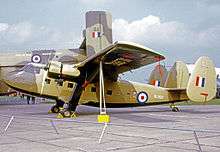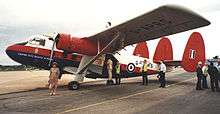Scottish Aviation Twin Pioneer
| Twin Pioneer | |
|---|---|
 | |
| Twin Pioneer prototype bearing Scottish Airlines markings at the 1955 Farnborough SBAC Show | |
| Role | Transport |
| Manufacturer | Scottish Aviation |
| First flight | 25 June 1955 |
| Introduction | 1956 |
| Retired | 1968 |
| Primary users | Royal Air Force Malaysia Nepal |
| Number built | 87 |
| Developed from | Scottish Aviation Pioneer |
The Scottish Aviation Twin Pioneer was a British STOL transport aircraft built by Scottish Aviation Limited at Prestwick Airport, Scotland, during the 1950s. It was designed for both civil and military operators. It was conceived as a twin-engined version of the Pioneer light transport. Both aircraft required "an area only 30m (99ft) by 275m (902ft) in which to operate." [1]
Design and development
Powered by two Alvis Leonides 531 radial engines, the Twin Pioneer was a high-wing cabin monoplane with a triple fin and rudder assembly and fixed tailwheel undercarriage.[2] The prototype Twin Pioneer, registered G-ANTP, first flew at Prestwick Airport on 25 June 1955. Flight trials proved that the aircraft had a very short landing run and the aircraft was displayed at the September 1955 Society of British Aircraft Constructors Show at Farnborough.[3][4]
Three pre-production aircraft were built for trials, and sales and demonstrations.
In 1958, the 33rd aircraft was used as a prototype for the Series 2 with Pratt & Whitney Wasp R-1340 radial engines which had been ordered by Philippine Air Lines. A Series 3 aircraft was also developed to use the improved Alvis Leonides 531 radial engine.
Operational history

The military version could carry external stores such as bombs under the stub wings. One aircraft became the first aircraft for the newly formed Royal Malaysian Air Force when it was delivered on 16 January 1962, the type served with the air force for 12 years.
The Royal Air Force ordered 39 aircraft, which were built between 1958 and 1959, deployed in Aden and the Far East. It was used extensively by British forces in the Malayan Emergency and the later confrontation in Borneo. In August 1959, No. 78 Squadron RAF at Khormaksar received some Twin Pioneers to supplement its single engine Pioneers. The Twin Pioneers were employed in moving troops and supplies around the wilderness and on occasions, lending support to the Sultan of Oman. A series of double engine failures caused problems with the squadron losing two aircraft on the same day. Unsuitable soft and hard landing strips were also causes of failures during landings.

Other squadrons that operated the Twin Pioneers were No. 152 Squadron RAF based at Muharraq in Bahrain: No. 21 Squadron RAF, which reformed with the type at Benson in May 1959. The squadron then moved to Kenya and in June 1965 to Aden. No. 152 operated around the Persian Gulf and in 1959, No. 209 Squadron RAF based at Seletar began to receive Twin Pioneers. These operated in Borneo and Malaya. The SRCU (Short Range Conversion Unit) at RAF Odiham also flew three Twin Pioneers for aircrew training. RAF No. 230 Squadron in the UK was the last military operator of the Twin Pioneer. The squadron operated the type in an interesting sand-colour camouflage scheme.
Although mainly used in military operations, the Twin Pioneer was also successful as a commercial transport for operation in areas without proper airfields, where unprepared surfaces were often the norm. Twin Pioneers were sold as survey aircraft to oil exploration companies with some of the first sales to Rio Tinto Finance and Exploration Limited, and the Austrian and Swiss government survey departments. Three were used by the 'Kroonduif' in Dutch New Guinea.
One Twin Pioneer served as a STOL training aircraft with the Empire Test Pilot School (ETPS) at RAE Farnborough for many years.
Variants
- Twin Pioneer : Prototype aircraft with Alvis Leonides 503 radial engines, one built.
- Twin Pioneer Series 1 : Production aircraft with Alvis Leonides 514 radial engines.
- Twin Pioneer CC.Mk 1 : Military version of the Series 1 for the Royal Air Force, 32 built.
- Twin Pioneer Series 2 : Production aircraft with Pratt & Whitney R-1340 radial engines.
- Twin Pioneer Series 3 : Production aircraft with Alvis Leonides 531 radial engines.
- Twin Pioneer CC.Mk 2 : Military version of the Series 3 for the Royal Air Force, 7 built.
Operators
Civil operators
- Austria
- Canada
- Dutch New Guinea
- Ecuador
- Iceland
- Indonesia
- Iran
- Kuwait
- Laos
- Malaysia
- Mexico
- Nepal
- Nigeria
- North Borneo
- Fjellfly, Norway
- Philippines
- Sierra Leone
- Switzerland
- United Kingdom
- United States
Military operators
- Royal Malaysian Air Force - 14 delivered
- Royal Air Force
- No. 21 Squadron RAF (RAF Eastleigh then RAF Khormaksar - May 1959 to September 1967)
- No. 78 Squadron RAF (RAF Khormaksar - October 1958 to June 1965)
- No. 152 Squadron RAF (RAF Muharraq - December 1958 to June 1965)
- No. 209 Squadron RAF (RAF Seletar - March 1959 to December 1968)
- No. 225 Squadron RAF
- No. 230 Squadron RAF (RAF Odiham - January 1960 to December 1961)
- Empire Test Pilots' School
- No. 224 Group Support Flight
- No. 1310 Flight RAF
- RAF Katuanayake Station Flight - one aircraft
- RAF Odiham Station Flight
- Short Range Conversion Unit - RAF Odiham
Incidents and accidents
- A recorded loss of a Twin Pioneer occurred on take off from Limbang Airport on 17 May 1967. The aircraft, operated by Malaysia-Singapore Airlines, carried the registration 9M-ANC. The cause was given as 'unknown.[5]
- In Royal Air Force service only three aircraft had fatal accidents:
- 2 March 1961 - XL966 of 21 Squadron flew into rising ground at Mount Meru, Tanganyika, one killed.
- 14 February 1963 - XN318 of 209 Squadron flew into a wooded cliff in Borneo, all five onboard killed.
- 18 April 1963 - XL994 of 152 Squadron dived into the ground near Bu Hafafa in Oman, all eight onboard killed.
Specifications (Twin Pioneer CC.Mk 2)

Data from Green.[6]
General characteristics
- Crew: Two (pilot and co-pilot)
- Capacity: Up to 13 troops or 2,000 lb (907 kg) of cargo
- Length: 45 ft 3 in (13.79 m)
- Wingspan: 76 ft 6 in (23.32 m)
- Height: 12 ft 3 in (3.73 m)
- Wing area: 670 ft² (62 m²)
- Empty weight: 10,062 lb (4,564 kg)
- Loaded weight: 14,600 lb (6,622 kg)
- Max. takeoff weight: 14,600 lb (6,622 kg)
- Powerplant: 2 × Alvis Leonides 531 radial engine, 640 hp (564 kW) each
Performance
- Maximum speed: 143 knots (165 mph, 266 km/h)
- Range: 695 nm (791 mi, 1,287 km)
- Service ceiling: 20,000 ft (6,098 m)
- Rate of climb: 1,250 ft/min (381 m/min)
See also
- Related development
- Aircraft of comparable role, configuration and era
- Related lists
References
Notes
- ↑ Royal Air Force Museum - Scottish Aviation Twin Pioneer www.rafmuseum.org.uk Retrieved: 11 May 2010
- ↑ Taylor 1961, p. 181.
- ↑ Hemming Air Enthusiast August to October 1993, p. 26.
- ↑ "Development of Twin Pioneer". The Glasgow Herald. 22 October 1956. Retrieved 24 November 2016.
- ↑ ASN Aircraft accident Scottish Aviation Twin Pioneer 1 9M-ANC Limbang Airport (LMN) aviation-safety.net Retrieved: 16 September 2010
- ↑ Green 1964, p. 269.
Bibliography
- Green, William. Macdonald Aircraft Handbook. London. Macdonald & Co. (Publishers) Ltd., 1964.
- Donald, David, ed. The Encyclopedia of World Aircraft. London: Aerospace Publishing, 1997. ISBN 1-85605-375-X.
- Hemming, Nick. "'Primrose' & Friends: The Scottish Aviation Twin Pioneer". Air Enthusiast, Fifty-one, August to October 1983. pp. 21–31.
- Taylor, John W. R. Jane's All The World's Aircraft 1961–62. London: Sampson Low, Marston & Co. Ltd, 1961.
- Thetford, Owen. Aircraft of the Royal Air Force 1918-57, 1st edition. London: Putnam, 1957.
External links
| Wikimedia Commons has media related to Scottish Aviation Twin Pioneer. |
- RAF Museum entry
- "Twin Pioneer - Large Loads from Small Fields" a 1955 Flight article